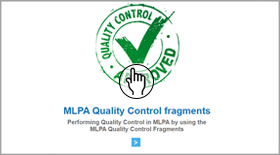Q- and D-fragments are present in SALSA® MLPA® probemixes for quality evaluation of an MLPA experiment.
Background
Four quantity fragments (Q-fragments) are present in each MLPA probemix at 64, 70, 76, and 82 nt. These Q-fragments are amplified independently of ligation. If sufficient sample DNA was used, and if the ligation step was successful, Q-fragments are quickly outcompeted by the exponentially amplified probes. Therefore, the Q-fragments are only visible in the presence of less than 100 ng of sample DNA or if the ligation step failed.
Two denaturation fragments (D-fragments) are present in almost all MLPA probemixes at 88 and 96 nt. D-fragments target extremely GC-rich sequences that are hard to denature, and thus give an indication if denaturation of your DNA sample was complete during the initial 5 minute 98°C DNA denaturation step. If a low signal for the 88 and 96 nt fragments is obtained in comparison to the 92 nt benchmark fragment, this indicates denaturation of your sample DNA was incomplete. A lower signal for only one of the two D-fragments may indicate another issue; contact us for assistance if required.
Almost all SALSA MLPA probemixes contain the aforementioned internal quality control fragments. Exceptions are noted in the product descriptions.
Click the image below to open our e-learning module about the quality control fragments for more detailed information. Detailed information can also be found in the (MS-)MLPA General Protocol.
